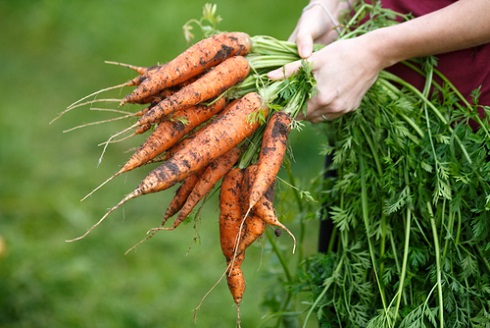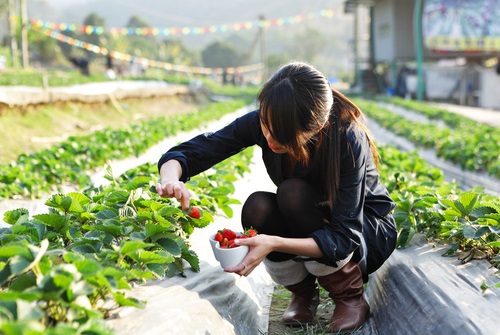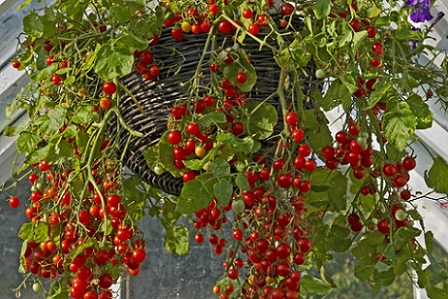We often talk about slow fashion, but ‘slow eating’ is starting to take over the food industry. And while following a veggie diet drastically reduces your ‘food print’, the truth is that the carbon cost of the food we eat every day is much heavier than we may realise. As avocados are flown in from Mexico, mangoes from the Philippines, and berries from across Europe, the environment is paying a heavy price for our consumption of imports. So, how can we reduce the carbon cost of the food we eat? The answer could be, quite literally, close to home.
Cruelty Free Beauty
- 4 signs you have low iron levels
- Zero Waste Beauty: Adopt a green routine with these sustainable products
- This eco-friendly beauty box is packed with refillable multi-taskers
- “I find myself using it even when I don’t need to!”
- Arctic-inspired natural skincare brand launches in the UK
- Green People launches beauty balm packaged in 100% biodegradable pot
- Lush launches same-day delivery service for its iconic handmade cosmetics
- “This cruelty-free tanning water gave me the confidence boost I needed”
- rho launches sustainable loungewear that gives back
- Rose & Caramel Raises Awareness For Women’s Self-Esteem & Mental Health With ‘I TAN FOR ME’ Campaign
- Couple launches entirely plant-based and refillable deodorant on Kickstarter
- View all
Eco Living
- Simple Hacks to Cut Your Food Waste with Gino D’Acampo
- Five Easy Ways to Reduce Food Waste
- Eat these foods to boost your mood
- Upgrade Your Cheese Toastie
- Have a healthy Christmas with these festive food swaps
- Omega-3 Health Benefits
- 5 minutes with Max La Manna
- A nutritionist’s guide to eating for healthy joints
- Easy ways to achieve your health goals
- Discover the benefits of raisins on a vegetarian diet
- Improve your gut health with California Raisins
- View all
Vegan Recipes
- Quorn Vegan Hot & Spicy Burger with Pink Slaw
- Tomato and Pumpkin Soup
- Pea and elderflower cocktail
- Matcha Coconut Ice Cream
- Vegan Lemon Bars
- Mango Salad with Thai Dressing
- Garden Gimlet
- Tofu & Green Beans Teriyaki
- Cornflakes Bombay
- Rainbow Pickle
- Soba noodles with kale and collards
- View all
Popular recipes
- Spinach and ricotta quiche vegetarian recipe
- Cheats mushroom and spinach lasagne vegetarian recipe
- Lentil bolognese vegetarian recipe
- Creamy mushroom stroganoff vegetarian recipe
- Malaysian Rendang curry vegetarian recipe
- Feta, Butternut Squash, Caramelised Onion and Cashew Nut Wellingtons
News
- Refillable delivery service bikes eco-brands to London consumers
- Vegan Snack Box Delivery Service Launches in the UK
- Charity provides free meals to children and families with surplus food
- UK’s First Plastic-Free Supermarket Opens In London
- Lipton launches sustainable cold brew range
- Bamigo’s bamboo clothing arrives in the UK
- Big Butterfly Count calls on public to help with conservation efforts
- Vegan makeup brand KVD is launching in Boots
- Pukka is using your tea purchases to plant trees
- Adidas announces plans to eliminate plastic for good
- Nourish London collaborates with Freeset to create gifts that give back
- View all
How to eat locally to reduce your carbon footprint
Find out how buying local, seasonal produce could benefit your own health as well as the planet’s

Reaping the benefits
Sourcing ingredients locally is one of the biggest ways we can reduce our environmental footprint with every shop. The concept of ‘local’ isn’t really defined, but most people consider it to be food that’s grown and produced less than 100 miles from where you live.
A 2018 survey by Lightspeed GMI and Mintel revealed that 78% of shoppers agreed that it’s important to support British farmers, whilst 40% of people said that British food tastes better – and we couldn’t agree more! Unfortunately, many people also admit to not checking labels to see where the food they’re buying comes from. What’s more, in 2017, the UK supplied just half of food consumed in the country, with the rest being imported from foreign suppliers.

While we live in a globalised world, it’s also important to support local producers and farmers who are championing British food, and the benefits are numerous. Not only does this help to boost the local economy, it’s also a great way of bringing communities together by connecting farmers, producers and consumers. When we choose to eat local produce, we’re helping to reduce the air miles attached with the import and export of such foods. This equates to fresher ingredients, as they won’t have travelled as far to reach us, which in turn also helps to reduce food waste. Produce that’s transported long distances will be grown and processed with the aim of increasing its shelf life, often at the expense of its nutritional benefits. Locally grown food, on the other hand, is likely to be organic, and more ripe, which means it contains more nutrients! Remember that it’s not just about fruit and veg: you can also find local baked goods, coffee and other drinks, too!
Do your research
Many of us are probably guilty of not knowing the origin or seasonality of common fruits and veg, so it’s worth taking a bit of time to understand what ingredients you can realistically buy locally – and you certainly won’t be short of options, because British produce is so colourful and varied! To learn what’s in season, you can find a list of UK-grown produce on websites such as the Vegetarian Society.
While we love adding variety into our diet and cooking international cuisine, there are some ingredients that aren’t traditionally grown in the UK, such as avocados, lentils, quinoa, pineapples, sweet potatoes, artichokes, butternut squash, melons and peanuts. It’s worth considering your consumption of these ingredients, and perhaps switching your shopping habits to lessen your environmental impact. For example, consider reducing your consumption of imported avocados to once a week rather than daily, and purchasing ones that are imported from closer to home, such as Spain, rather than Mexico. Keep in mind that some UK producers now grow non-traditional foods like these, so it’s always worth checking whether you can source ingredients here.

Ripe for the picking
Shopping at farmer’s markets is a great way of ensuring that you’re buying local, fresh, seasonal produce. If you don’t have a market near you, or you’re short on time, then there are several schemes that provide organic food delivery services, including Riverford, Abel and Cole, and Pikt. Be sure to check products before you buy them, though, as schemes may provide a selection of both local and international produce.
You can also visit a pick-your-own farm to select in-season produce such as runner beans, pumpkins, tomatoes, apples, sloe berries and strawberries – you could even use these to make your own pickled veggies and jams!
Want to take things one step further? Community Supported Agriculture (CSA) schemes connect farmers and consumers who create a partnership in which the responsibility for farming is shared. The ultimate way to take ownership of the food system, you can be as involved as you wish to be, whether it’s owning or investing in a farm or business, or providing labour.

Do it yourself
What could be more local than your own allotment or home garden? Growing your own fruit, vegetables and herbs may be more time-consuming, but the satisfaction of plucking ripe tomatoes off the vine is definitely worth it. If you find the concept overwhelming, don’t panic. It’s easier than you think, as our friends at sister publication Grow Your Own tell us…
“Growing your own veg is the ultimate planet-friendly way of producing food. Why? Because you’re in control. No food miles, no plastic packaging, no unnecessary pesticides – and you don’t even need tonnes of space to get started!
“Try tumbling tomatoes in a hanging basket for a bounty of juicy red fruits, cultivate an array of flavoursome herbs on a south-facing windowsill, or find a short-rooted carrot variety that will thrive in a plant pot on your balcony or patio.
“You don’t need to become Monty Don overnight to enjoy home-grown harvests. In fact, part of the fun is the trial-and-error nature of vegetable gardening. So, get your hands dirty, give it a go, and you’ll soon be reaping the benefits of fresh produce at your fingertips.”
More from Vegetarian blog

It's World Vegetarian Day on the 1st, a day to celebrate our community and our care for the lives of animals. Don’t turnip your nose, lettuce tell you about all of our Veggie loves – and be sure to share yours with us on social media too...

This month is Sustainable Fashion Month, focusing on all things ethical in the fashion world. As a nation our thirst for fashion is hugely impacting the environment, so let's raise awareness of this important issue and champion those working to make the fashion industry a more moral place.

There's nothing better than finding a delicious, nutritious recipe that you can rustle up on a budget, so we've made a list of healthy recipes that are cheap and cheerful

Gnocchi makes a welcome change from pasta, especially for us veggies! If you only cook them halfway they will keep in the refrigerator for 2-3 days and can also be frozen. At serving time, simply cook them quickly in salted boiling water. Bellissimo!

If you're bored of avo-toast, the craze taking Instagram by storm, you've hopped off the bandwagon at the right stop as we've put together a list of new and exciting ways of using avocado...




